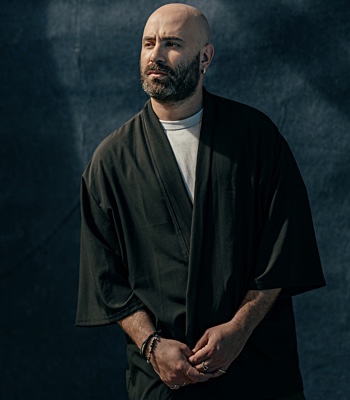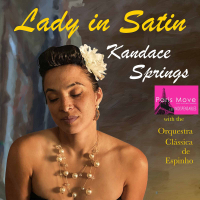Home » Jazz Musicians » Bessie Smith
Bessie Smith
“Empress of the Blues”
She embodied the meaning of the blues, living the life she sang about. Bessie Smith set the standard for blues singers on how it should be done.
Bessie Smith, born on Apr. 15, 1894, in Chattanooga, Tennessee, was one of ten children. Her parents died by her eighth birthday, and she was raised by her older sister Viola. She was taught to sing and dance by her older brother Clarence, who later arranged an audition for Smith with the traveling Moses Stokes Show where she was hired as a dancer in 1912. She became friends with Gertrude "Ma" Rainey, a blues singer, who became her mentor. Bessie was quick to learn the profession, and by 1915 struck out own her own, singing in a vaudeville circuit and started establishing a reputation in the south and on the east coast.
By 1920 she had become quite the star, and continued to work the crowds, blending a touch of comedy, sense of drama, with a down home sense of delivery from her powerful voice. Her popularity led to the inevitable recording contract, and on February 16, 1923, she recorded "Gulf Coast Blues" and "Down Hearted Blues," for Columbia accompanied by Clarence Williams on piano. Written and recorded by Memphis singer Alberta Hunter a year before, Bessie’s version of "Down Hearted Blues" sold more than 750,000 copies in six months, and made her a star.
She continued to record almost exclusively for Columbia, was the labels biggest star, recording over 150 songs between 1923 and1931, with constantly high sales figures. Bessie Smith’s live performances were equally successful; she toured incessantly, commanded fees of $2,000 a week and played sold out theaters across America, to both white and black audiences alike. She recorded with the best jazz sidemen, including pianists Fletcher Henderson and James P. Johnson, clarinetists Benny Goodman and Buster Bailey, guitarist Eddie Lang, saxophonists Coleman Hawkins and Don Redman, and the great Louis Armstrong. “St. Louis Blues” with Armstrong is a highlight in the recordings of the period, and considered one of the best renditions of the song. In May 1925, she made the first electronically recorded record, "Cake Walking Babies," by singing into the newly invented microphone. Bessie’s songs have gone on to become blues standards and include “Backwater Blues”, “Nobody Knows You When You’re Down and Out”, Empty Bed Blues”, “Careless Love”, and the all time classic “Gimme a Pigfoot”. She had a starring role in the movie St. Louis Blues which came out in 1929. Her recordings are available as compilations under a variety of labels.
Read moreTags
Trilogy, Jose Luiz Martins, Jeff Libman, Medler Sextet, Nancy Kelly Plus Celebrations For Carline Ray, Bessie Smith & More

by Mary Foster Conklin
This broadcast continues the celebration of Jazz Appreciation Month with new releases from Trilogy, Jose Luiz Martins, Jeff Libman, Medler Sextet and Nancy Kelly, with birthday shoutouts to Carline Ray (100!), Bessie Smith, Madeleine Peyroux, Judy Wexler, Roxy Coss and Tia Fuller, among others. Happy listening and please support the artists you hear--see them live, buy their music so they can continue to comfort, distract, provoke and remind the world that A Woman's Place is in the Groove. Many thanks ...
Continue ReadingNew Releases From Nicole Glover, Alyssa Allgood, Cory Weeds Meets Champian Fulton, A Celebration For Bessie Smith's 130th Birthday & More

by Mary Foster Conklin
Jazz Appreciation Month continues with new releases from Nicole Glover, Alyssa Allgood, Cory Weeds Meets Champian Fulton, Mahogany L. Browne & Sean Mason and a single from Madeleine Peyroux, with birthday shoutouts to Bessie Smith, Michelle Lordi, Wendy Kirkland, Judy Wexler, Carol Fredette, Roxy Coss and Madeleine Peyroux, among others. Thanks for listening and please support the artists you hear by seeing them live and online. Purchase their music so they can continue to distract, comfort, provoke and inspire.
Continue ReadingQueer Blues: The Hidden Figures Of Early Blues Music

by Ian Patterson
Queer Blues: The Hidden Figures Of Early Blues Music Darryl W. Bullock 352 Pages ISBN: 978-1-9131-7252-7 Omnibus Press 2023 The blues is ripe with legends and myths, not least the oft-touted claim that W.C. Handy was the father of the blues. But as Darryl. W. Bullock tells it, there is an important tract of blues history that has not got its due. Until now. In his telling, many of the blues pioneers were ...
Continue ReadingNew Releases, Bistro Awards, Birthday Shoutouts To Bessie Smith & More

by Mary Foster Conklin
This broadcast includes new releases from Allegra Levy, Champian Fulton and John Pizzarelli, with singles from Nicky Schrire and Nicole Zuraitis, plus birthday shoutouts to Empress of the Blues Bessie Smith, Haruna Fukazawa, Nancy Winston, Michele Brourman and Herbie Hancock, among others with a salute to some of this year's Bistro Award winners. Thanks for listening and please support the artists you hear by seeing them live and online. Purchase their music so they can continue to distract, comfort, provoke ...
Continue ReadingBirthday Celebrations for Bessie Smith and Herbie Hancock Plus New Releases From Rosalyn McClore and Yulia Musayelyan

by Mary Foster Conklin
This broadcast features new releases from vocalist Rosalyn McClore and flutist Yulia Musayelyan with birthday shoutouts to Bessie Smith, Wendy Kirkland, Tia Fuller, Judy Wexler, Vanessa Perica, Herbie Hancock, Haruna Fukazawa, Pete Malinverni and Michelle Lordi, among others. Thanks for listening and please support the artists you hear by purchasing their music during this time of lockdown.Playlist Wendy Kirkland “Haven't We Met" from The Music's On Me (Blue Quaver Records) 00:00 3D Jazz Trio “Besame Mucho" from I ...
Continue ReadingNobody Knows You When You're Down and Out - Celebrating Bessie Smith

by Mary Foster Conklin
Halfway through April, which is also Jazz Appreciation Month, the broadcast includes new releases from vocalist Nanette Frank, composer Wayne Alpern, trumpeter Johnny Summers and pianist Monika Herzig, with birthday shoutouts to the Empress of the Blues, Bessie Smith, pianist Herbie Hancock, plus vocalists Marilyn Maye and Dusty Springfield. Thanks for listening and please support the artists you hear by purchasing their music. Playlist Lisa Hilton “Rush Hour Rhapsody" from Chalkboard Destiny (Ruby Slippers) 00:00 Nanette Frank “How ...
Continue ReadingThe Empress of the Blues

by Mary Foster Conklin
This broadcast opens with a celebration of the music of Bessie Smith, the Empress of the Blues, in honor of her birthday, with new releases from saxophonist Melissa Aldana, vocalists Emma Larsson, Marc Jordan, Joanna Wallfisch and Claire Martin, plus more birthday shout outs to Dusty Springfield and Carline Ray (member of the International Sweethearts of Rhythm and mother of Catherine Russell). Playlist Jen Hodge “Chocolate Magic Mushrooms" from All's Fair in Love and Jazz (Self released) 00:00 ...
Continue ReadingJazz Musician of the Day: Bessie Smith

Source:
Michael Ricci
All About Jazz is celebrating Bessie Smith's birthday today!
“Empress of the Blues” She embodied the meaning of the blues, living the life she sang about. Bessie Smith set the standard for blues singers on how it should be done. Bessie Smith, born on Apr. 15, 1894, in Chattanooga, Tennessee, was one of ten children. Her parents died by her eighth birthday, and she was raised by her older sister Viola. She was taught to sing and dance by her ...
read more
Jazz Musician of the Day: Bessie Smith

Source:
Michael Ricci
All About Jazz is celebrating Bessie Smith's birthday today!
“Empress of the Blues” She embodied the meaning of the blues, living the life she sang about. Bessie Smith set the standard for blues singers on how it should be done. Bessie Smith, born on Apr. 15, 1894, in Chattanooga, Tennessee, was one of ten children. Her parents died by her eighth birthday, and she was raised by her older sister Viola. She was taught to sing and dance by her ...
read more
Jazz Musician of the Day: Bessie Smith

Source:
Michael Ricci
All About Jazz is celebrating Bessie Smith's birthday today!
“Empress of the Blues” She embodied the meaning of the blues, living the life she sang about. Bessie Smith set the standard for blues singers on how it should be done. Bessie Smith, born on Apr. 15, 1894, in Chattanooga, Tennessee, was one of ten children. Her parents died by her eighth birthday, and she was raised by her older sister Viola. She was taught to sing and dance by her ...
read more
Jazz Musician of the Day: Bessie Smith

Source:
Michael Ricci
All About Jazz is celebrating Bessie Smith's birthday today! “Empress of the Blues” She embodied the meaning of the blues, living the life she sang about. Bessie Smith set the standard for blues singers on how it should be done. Bessie Smith, born on Apr. 15, 1894, in Chattanooga, Tennessee, was one of ten children. Her parents died by her eighth birthday, and she was raised by her older sister Viola. She was taught to sing and dance by her ...
read more
Jazz Musician of the Day: Bessie Smith

Source:
Michael Ricci
All About Jazz is celebrating Bessie Smith's birthday today!
“Empress of the Blues” She embodied the meaning of the blues, living the life she sang about. Bessie Smith set the standard for blues singers on how it should be done. Bessie Smith, born on Apr. 15, 1894, in Chattanooga, Tennessee, was one of ten children. Her parents died by her eighth birthday, and she was raised by her older sister Viola. She was taught to sing and dance by her ...
read more
Jazz Musician of the Day: Bessie Smith

Source:
Michael Ricci
All About Jazz is celebrating Bessie Smith's birthday today!
“Empress of the Blues” She embodied the meaning of the blues, living the life she sang about. Bessie Smith set the standard for blues singers on how it should be done. Bessie Smith, born on Apr. 15, 1894, in Chattanooga, Tennessee, was one of ten children. Her parents died by her eighth birthday, and she was raised by her older sister Viola. She was taught to sing and dance by her ...
read more
Jazz Musician of the Day: Bessie Smith

Source:
All About Jazz is celebrating Bessie Smith's birthday today!
“Empress of the Blues” She embodied the meaning of the blues, living the life she sang about. Bessie Smith set the standard for blues singers on how it should be done. Bessie Smith, born on Apr. 15, 1894, in Chattanooga, Tennessee, was one of ten children. Her parents died by her eighth birthday, and she was raised by her older sister Viola. She was taught to sing and dance by her ...
read more
Jazz Musician of the Day: Bessie Smith

Source:
Michael Ricci
All About Jazz is celebrating Bessie Smith's birthday today!
JAZZ MUSICIAN OF THE DAY Bessie Smith
Bessie Smith- vocalist, composer, recording artist (1894-1937) “Empress of the Blues” She embodied the meaning of the blues, living the life she sang about. Bessie Smith set the standard for blues singers on how it should be done... more
Website | Photos | Articles
Follow Bessie Smith
Put AAJ's Musician of the Day box ...
read more
Jazz Musician of the Day: Bessie Smith

Source:
Michael Ricci
All About Jazz is celebrating Bessie Smith's birthday today!
JAZZ MUSICIAN OF THE DAY Bessie Smith
Bessie Smith- vocalist, composer, recording artist (1894-1937) “Empress of the Blues” She embodied the meaning of the blues, living the life she sang about. Bessie Smith set the standard for blues singers on how it should be done... more
Website | Videos | Articles
Follow Bessie Smith @ AAJ
Put AAJ's Musician of the ...
read more


















































